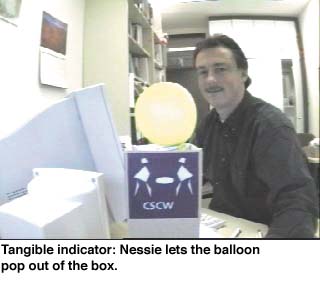
ERCIM News No.36 - January 1999

![]()
ERCIM News No.36 - January 1999
NESSIE - Awareness Environment
by Wolfgang Prinz
The NESSIE project develops an infrastructure through which the events in an electronic environment can be captured, communicated and presented across the Internet.
The support of awareness is an important requirement for the successful implementation of groupware applications, and for the use of the Internet as a social medium. Awareness involves the perception of important events and relevant actions of remote partners engaged in synchronous or asynchronous cooperation. It is important that the notification occurs in social and task-related contexts and that longer periods of absence between notifications can be bridged, eg, through summary reports or multimedia process visualizations.
The goal of NESSIE is the development of an infrastructure through which the events in an electronic environment can be captured and made available to authorized users across the Internet. It should be possible to signal all kinds of events, in particular, presence, actions and movements of other participants, agents, or objects. The NESSIE System is not bound to a specific application, but instead offers its services globally, across applications.
Architecture
The NESSIE system consists of a server, which uses an open protocol to receive event information from any type of application. Through a client, users - or other programs - can register their requests for event information with the NESSIE server. Additionally, the type and conditions of the indicators can be individually configured. This serves as the technical basis for reciprocal perception of events and for group awareness in a Social Web.
NESSIE can also be used to set up a personal information service that monitors and reports the events in an electronic environment. Events might range from learning who is visiting one’s homepage to an individually configured Push-Service, which would announce a traffic jam as one heads home in the evening.
Presentation Form
NESSIE uses various representations to show events, eg PopUp windows, animations, ticker tapes, or sound. Beyond electronic representation, the NESSIE project experiments with tangible interfaces which support presentation of events independent of a computer screen.

Three-dimensional virtual environments provide a new medium for the presentation of events. For this purpose, NESSIE uses the SmallView system developed at the GMD Institute for Applied Information Technology to establish a connection between real and synthetic virtual environments. SmallView, which is based on the Internet standard VRML (Virtual Reality Modeling Language) for the visualization of three-dimensional scenes, lets several users communicate and interact across the Internet within a distributed virtual environment. Gestures and actions of the user may be captured by sensors such as MOVY, a prototype developed in GMD Institute for Applied Information Technology, which can sense acceleration, determine rotation and movement of an object and radio the information to a local computer system.
Partner in the NESSIE project is the StatOil Research Center, Norway. NESSIE is part of our research program The Social Web: New Forms of Interaction in Virtual Environments (http://orgwis.gmd.de/projects/SocialWeb).Please contact:
Wolfgang Prinz - GMD
Tel: +49 2241 14 2730
E-mail: wolfgang.prinz@gmd.de